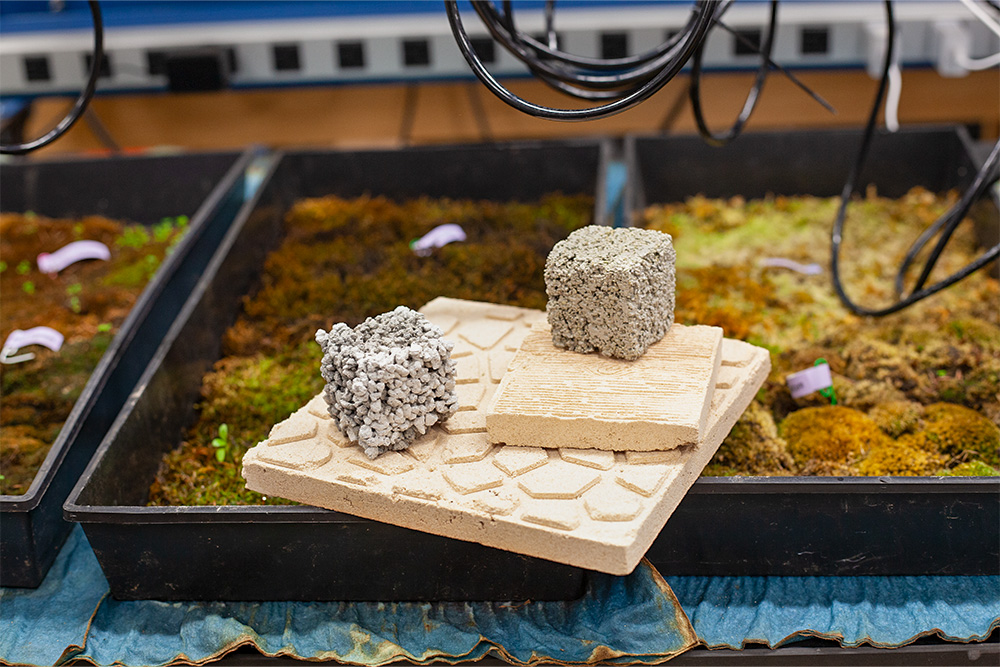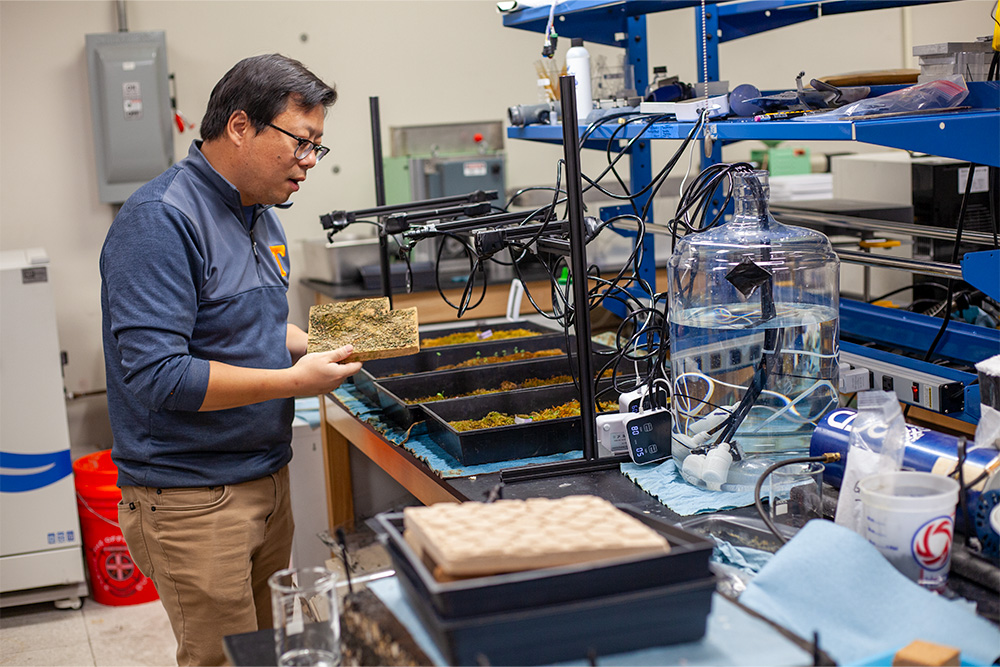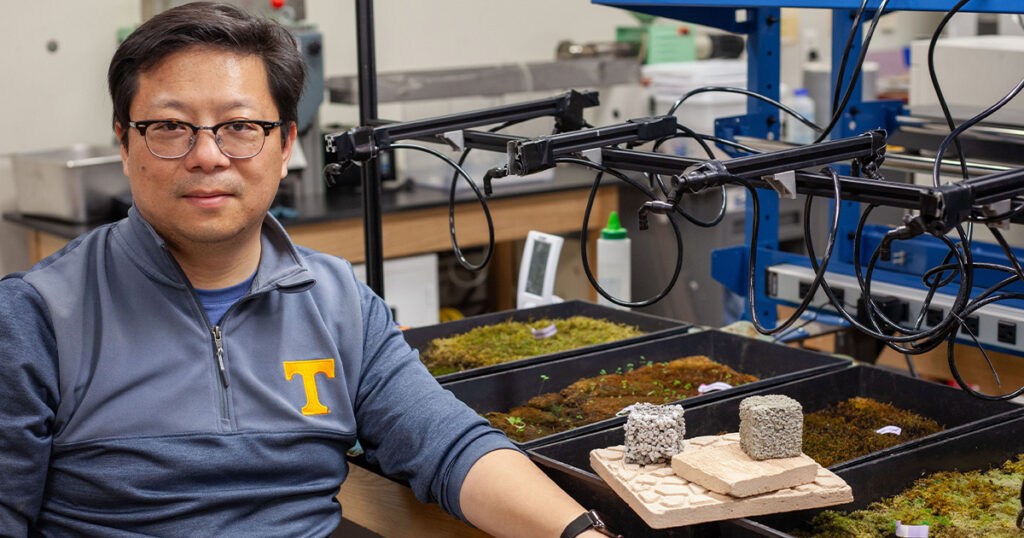Rethinking Green Infrastructure
What if you surfaced a house with the tile of the future… and it started melting in the rain?
“The first formulation I came up with started to melt after a week,” said Peyman Zandifaez, a postdoctoral fellow in the Department of Civil and Environmental Engineering (CEE). “I had to come up with another idea so we could increase the strength of the sample while having all the other features we need.”
Those features include a relatively low pH (acidic) surface, the ability to retain and slowly release water, and a texture that moss—yes, moss—can cling to.
“Bioreceptive construction integrates living organisms into architecture,” said CEE Associate Professor Nick Zhou. “What makes our project fundamentally different is that we’re trying to make the entire surface of the building bioreceptive.”
In 2023, Zhou received funding from the United States Defense Advanced Research Projects Agency (DARPA) as part of the agency’s push to cool acre-scale spaces through innovative landscaping.
Zhou’s proposed solution is Phyto-activated functional Living Material (PhantoM), a bioreceptive material that can turn any constructed surface into a self-sustaining moss garden. Three of his postdoctoral fellows—Zandifaez, Yawen He, and Jiarui Zhang—have been helping to bring the system to life.
“Mosses are particularly compelling for urban sustainability because they provide passive cooling with minimal maintenance,” said He, who is working alongside Zhang to develop a physics-based model to predict PhantoM’s performance in various conditions.
Over the last two years, the team has overcome many setbacks, including a three-month period struggling to align real-world environmental fluctuations with the demanding precision needed to create a baseline model.
“There’s no way you can go in the lab, do the experiment, and get what you want on the first try,” said Peyman. “If that was a thing, everyone would be a researcher.”
Their perseverance paid off; the PhantoM system is ready for its first real-world test this summer. The team will construct a six-foot-tall shed on the University of Tennessee’s Knoxville campus, fully coat it in PhantoM, and spray on moss.
A Tile Made of Tiny Sponges
Mosses are well adapted to urban environments. They thrive in acidic conditions, and most concrete surfaces become acidic as they age. They can also fully recover after losing up to 80% of their internal water.
That means the PhantoM substrate needs to retain enough water to keep mosses at or above that crucial 20% moisture level—but not so much that the tiles dissolve.
The key, Zandifaez found, was using hollow spheres of fly ash called cenospheres, which can absorb water without compromising the binding agents in the substrate.

Unfortunately, that solution caused another problem. While typical concrete becomes acidic over time through weathering, PhantoM is intended to host moss from the moment of installation. However, the initial substrate made with Zandifaez’s cenosphere formulation had a pH of nearly 13—the pH of bleach.
Over months of tweaking and testing, Zandifaez discovered that some time in a high-CO2 chamber and a soak in tannic acid lowers PhantoM’s pH to a moss-tolerable eight.
“The new combination meets the surface chemistry, surface pH, and humidity that we want,” he said.
After two months, samples of the latest prototype were completely covered in fresh growth of four local mosses—three species from North Carolina and one which Zandifaez gathered from a parking lot near the site of the future shed.
Just How “Cool” is PhantoM?
As Zandifaez tweaked the substrate recipe, He and Zhang worked to predict how much cooling effect the entire system would provide under different conditions—which required creating and calibrating an accurate model of PhantoM’s hygrothermal behavior (coupled heat and moisture dynamics).
They integrated dozens of inputs, including the average height of each moss species, the amount of heat and water lost through evaporation from both the moss and substrate, and even the heat from solar radiation.

“Bridging theoretical predictions and real-world measurements was one of the more challenging aspects,” He said. “Another key difficulty was calibrating all the interdependent physical parameters.”
He and Zhang teased apart the complex hygrothermal network by splitting it into two parts; Zhang calibrated parameters related to the substrate, while He focused on the hygrothermal dynamics of PhantoM’s living system.
While the inherent complexity of the model was difficult to implement, He and Zhang’s attention to detail means that their model will be able to predict and optimize PhantoM deployment across diverse climates. It could even inform the design and deployment of other green infrastructure systems, such as green roofs and facades.
“PhantoM integrates biological intelligence with engineered systems to address pressing environmental challenges,” said He. “This project represents a shift toward living architecture—a fusion of ecology, material science, and sustainable design.”
Contact
Izzie Gall (865-974-7203, egall4@utk.edu)
